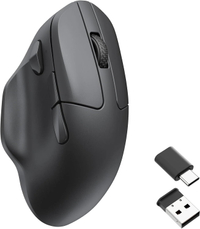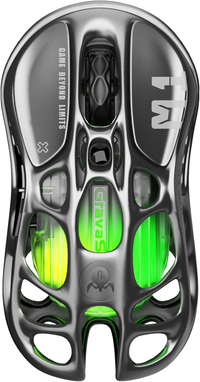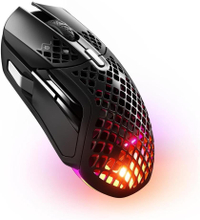The best wireless gaming mouse in 2024
Choose the best wireless gaming mouse to improve your setup

The best wireless gaming mouse can deliver performance on par with the best mice overall. Lag, imprecision and dropped signals are a thing of the past — provided you buy a high-quality mouse from a reputable manufacturer. These peripherals can make a big difference during intense online gaming sessions.
As with other PC gaming peripherals, not every wireless gaming mouse is created equal. The Tom’s Guide staff has reviewed dozens of wireless gaming mice from trusted brands such as Corsair, Logitech, Razer and SteelSeries. We've found that each offers a different experience, and can help you decide the best for you.
Here, we’ve rounded up the best wireless gaming mice, from inexpensive laptop accessories to top-of-the-line desktop peripherals. Which one best fits your needs? Read on to find out.
The best wireless gaming mouse you can buy today
Why you can trust Tom's Guide

Specifications
Reasons to buy
Reasons to avoid
If you're in the market for what's arguably the very best wireless gaming mouse then you'll want to check out the Logitech G502 X Lightspeed. It has pretty much everything one needs from a gaming mouse, and thanks to custom wireless connectivity it won't lose precision due to the lack of a wired connection.
Blending a comfortable design with textured grips and customizable buttons, the G502 X Lightspeed is a solid upgrade over its predecessor. Despite all the features, including customizable RGB lighting via the Logitech G Hub if you go for the Plus variant, the G502 X Lightspeed is still a very functional mouse that doesn't feel overwhelming to use.
There only caveat is its high price, which is double that of the wired version. And for hardcore gamers, the Logitech design might not appeal compared to some niche brands of gaming mice. But we still feel the Logitech G502 X Lightspeed sets a very high watermark for wireless gaming mice, and indeed gaming mice in general.
Read our full Logitech G502 X Lightspeed review.

Specifications
Reasons to buy
Reasons to avoid
You don’t have to settle for less with the ultra-light Redragon M916. Weighing in at just 1.7 ounces and packing a 4,000hz polling rate, it really raises the bar of what is possible for a budget gaming mouse.
It’s a little on the small side, but is packed with customization and features, with angle snapping, ripple control, and an adjustable debounce time which is perfect if you want maximum performance in a minimalist package. A slightly boring visual design and cheap-feeling plastic won’t win everyone over, but the M916 is one of the lightest mice we have reviewed and a fantastic option for those looking for a wireless mouse below $50.
Read our full Redragon M916 review.

3. Razer DeathAdder V2 Pro
Specifications
Reasons to buy
Reasons to avoid
The Razer DeathAdder V2 Pro comes from a proud tradition of Razer DeathAdder mice. With its comfortable design and robust functionality, it’s no surprise that the DeathAdder has been on the market for 15 years, or that it’s sold more than 10 million units in that time.
If you’ve never used a DeathAdder, it’s sort of the template for a modern gaming mouse, with an ergonomic shape, a handful of programmable buttons and a robust software suite in Razer Synapse.
The DeathAdder V2 Pro is simply a wireless variant of the wired DeathAdder V2, which also features a textured scroll wheel, coarse grips and a little tasteful RGB lighting. While the DeathAdder V2 Pro isn’t the fanciest wireless gaming mouse on the market, it’s incredibly intuitive, and not too expensive. It ain’t broke, and Razer hasn’t fixed it.
Read our full Razer DeathAdder V2 Pro review.

Specifications
Reasons to buy
Reasons to avoid
For small and simple gaming mice, the SteelSeries Rival 3 Wireless is hard to beat. This mouse is about as no-frills as you can get, assuming you still want a high-quality peripheral from a major manufacturer. It costs less than $50, making it an incredibly good deal among wireless gaming mice. Even apart from the price, though, the Rival 3 Wireless boasts good performance, intuitive software and an ergonomic design. There are no grips, and only one tiny RGB lighting zone, though, so know what you’re getting into.
On the bright side, the mouse can switch effortlessly between USB and Bluetooth wireless, and SteelSeries claims that the mouse can last for up to 400 hours on two AA batteries. Granted, this means that you’ll have to replace batteries periodically rather than simply recharging them, which can be a pain.
Read our full SteelSeries Rival 3 Wireless review.
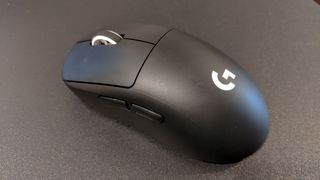
Specifications
Reasons to buy
Reasons to avoid
The Logitech G Pro X Superlight demonstrates that you can have an unbelievably lightweight mouse without opting for a distracting honeycomb aesthetic. While the G Pro X weighs just 2.2 ounces, it packs a ton of performance, with an accurate sensor, an ergonomic design and two well-placed thumb buttons.
The interesting thing about the G Pro X Superlight is just how unadorned it is. There's no RGB lighting; there are no textured grips; there's no customization potential. What you get in return, though, is one of the absolute lightest gaming mice on the market, with a rechargeable 70-hour battery and easy-to-use Logitech G Hub software. While the G Pro X Superlight is pretty expensive, it's also worth the price for esports aficionados. You can also pair it with the Logitech PowerPlay mousepad for constant charging.
Read our full Logitech G Pro X Superlight review.
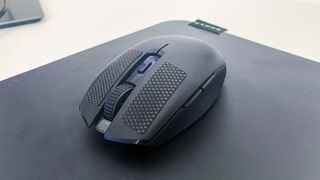
Specifications
Reasons to buy
Reasons to avoid
Most wireless gaming mice are large beasts, designed for large batteries and even larger hands. That's not the case with the Razer Orochi V2, a tiny peripheral that goes well with gaming laptops.
The Orochi V2 measures only 4.2 x 2.3 x 1.5 inches, which means it will fit comfortably in backpacks, laptop bags and small hands. It also supports claw, palm and fingertip grips, which isn't the case with every gaming mouse.
While the Orochi V2 doesn't have a rechargeable battery, a single AA will net you up to 40 days of battery life, provided you work in Bluetooth mode. (USB wireless isn't quite as efficient.) The mouse also doesn't come with RGB lighting, but that's not a huge drawback if performance is your top concern.
Read our full Razer Orochi V2 review.
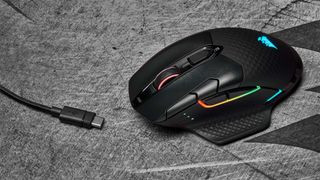
Specifications
Reasons to buy
Reasons to avoid
If you want your desktop to be as wireless as possible, you should turn to devices that also charge wirelessly. The Corsair Dark Core RGB Pro SE is one of the few gaming mice that offers wireless Qi charging, and the feature works pretty well. The battery lasts up to 50 hours, and you can use the mouse in either USB or Bluetooth wireless modes. That's more than a week of average use, or just under a week of heavy use.
The Dark Core RGB Pro SE has great in-game performance, colorful RGB lighting and even a swappable side panel, depending on whether you want an extra grip for your outermost fingers. At less than $100, the mouse isn't even that expensive, making it one of the better deals on this page.
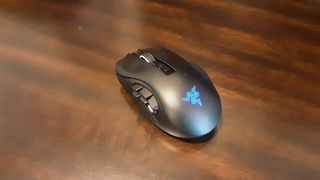
Specifications
Reasons to buy
Reasons to avoid
The Razer Naga Pro is possibly the best massively multiplayer online (MMO) gaming mouse on the market, but it has the potential to be a whole lot more than that, too. Like most MMO mice, the Naga Pro has a large side panel with a dozen extra buttons. Unlike most MMO mice, however, the Naga Pro also has two other swappable side panels, which you can use if you prefer a six- or two-button setup instead. As such, the Naga Pro is a surprisingly versatile tool.
Granted, you'll pay a lot of money for that kind of flexibility, and some of the side panels work better than others. It's also disappointing that the Naga Pro doesn't offer a "hex" panel design, as the wired Razer Naga Trinity did. But you do get excellent performance and long battery life.
Read our full Razer Naga Pro review.
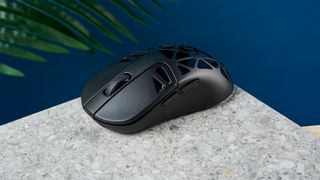
Specifications
Reasons to buy
Reasons to avoid
The Keychron M3 Mini 4K Metal is an excellent gaming mouse thanks to its performance and construction. Its 4,000Hz polling rate and 26,000 DPI ensure ultra-responsive and precise cursor movements, making it a great choice for first-person shooters, third-person RPGs, and even social simulation games like Sims 4. The mouse’s buttons are quick to register your clicks too. You also have three connectivity options — a 2.4GHz dongle, Bluetooth, and wired — but you’ll need to use the dongle to achieve the 4,000Hz polling rate.
The M3 Mini 4K Metal is built well. Its body is made of magnesium alloy, and the mouse weighs only 2.25 ounces. And while it’s light, the mouse still feels sturdy and is comfortable to use for long periods with a palm grip.
But the perforated design might not be everyone’s cup of tea, and you’ll have to be careful with your drink. The perforated design also makes it difficult to use the M3 Mini 4K Metal with a claw grip. The gimmicky dongle — which looks like a mini Keychron board — might put some people off too as it’s impractical to store.
Despite these minor flaws, though, the M3 Mini 4K Metal is a lightweight powerhouse that won’t let you down in tense shootouts and battles.
Read our full Keychron M3 Mini 4K review.
How to choose the best wireless gaming mouse for you
Choosing the best wireless gaming mouse for your setup comes down to three main factors: Size, connectivity and price.
Size is the easiest choice to make, as you probably already know whether you prefer large or small mice. If you have large hands or prefer holding mice in a claw grip, you might want a larger mouse. If you have small hands or intend to use your mouse primarily as a laptop accessory, you might want a smaller mouse.
Connectivity is also relatively easy to gauge. Some gaming mice offer wireless connectivity over USB and Bluetooth; others just offer USB. If you intend to use your mouse with a desktop, all you need is USB. If you want to use your mouse with mobile devices or a laptop with few USB ports, Bluetooth can be useful.
Finally, there's price. Wireless gaming mice generally range from $50 up to $150, with expensive models offering more features. Bear in mind that cheaper models tend to be smaller, too.
How we test wireless gaming mice
Tom's Guide tests wireless gaming mice the same way it tests any other gaming peripheral. We use the device as our primary mouse for a few days, evaluating the overall shape, weight and comfort level. Then, we'll dive into at least four different games across four different genres, testing whether the mouse has any particular strengths or weaknesses in-game.
Whenever possible, we'll also spend time manipulating a gaming mouse's software suite, seeing how easy it is to reprogram buttons, adjust RGB lighting and create profiles for individual games.
For wireless mice in particular, battery life is a big concern. As such, we'll monitor how quickly the battery runs down, how long the mouse takes to recharge and how much of a difference options such as lighting and connectivity type make. While we can't always measure a mouse's full battery life from start to finish, we can usually extrapolate after a few days.
Also tested
Keychron M7: $54 @ Amazon
The Keychron M7 is a high-performing gaming mouse with a maximum DPI of 26,000 and a 1,000Hz polling rate which make it a compelling choice for FPS and RPGs. With a lightweight yet sturdy body, this is an ergonomically friendly mouse for right-handed people. However, there’s no onboard dongle storage, its battery life is disappointing, and there’s no left-handed variation.
GravaStar Mercury M1 Pro: was $139 now $99 @ Amazon
The GravaStar Mercury M1 Pro is a gaming mouse that looks like no other, and it’s sure to garner attention if it’s on your desk. But that’s not all. The mouse also wows with its gaming performance thanks to the 1,000Hz polling rate and 26,000 DPI.
SteelSeries Aerox 5: was $139 now $125 @ Amazon
The SteelSeries Aerox 5 is a very good mouse, offering a great level of versatility thanks to the nine customizable buttons on a lightweight case, which makes the mouse appealing to both casual and competitive gamers alike. However, a very poor battery life makes it hard to recommend if you want maximum performance on a purely wireless mouse. If you aren’t yet sold on the honeycomb design, I would still recommend giving the Aerox 5 a shot — like me, you might still be converted to appreciating the rather holey aesthetic.
Sign up to get the BEST of Tom's Guide direct to your inbox.
Get instant access to breaking news, the hottest reviews, great deals and helpful tips.
Marshall Honorof is a senior editor for Tom's Guide, overseeing the site's coverage of gaming hardware and software. He comes from a science writing background, having studied paleomammalogy, biological anthropology, and the history of science and technology. After hours, you can find him practicing taekwondo or doing deep dives on classic sci-fi.
